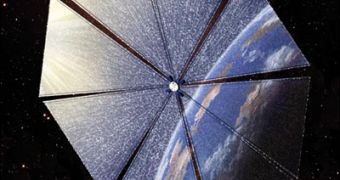In 1920 the Russian scientist Constantin Tiolkovski wrote "The pressure of solar light could be applied to spacecrafts which have already defeated Earth's gravitational pull".
In a novel published in 1865, Jules Verne speculated that light might someday be used "as a mechanical agent" to propel a spacecraft between the planets.
They were talking about using solar radiation pressure, the so-called "solar wind". The idea was again debated in the 1950s, but the technological means to transform it to reality did not exist at that time.
Mariner 4 was the fourth in a series of spacecraft used for planetary exploration in a flyby mode and performed the first successful flyby of the planet Mars, returning the first pictures of the Martian surface. It captured the first images of another planet ever returned from deep space; their depiction of a cratered, seemingly dead world shook the scientific community. Mariner 4 featured solar pressure vanes which extended from the ends, also called solar sails
Solar sails are a proposed form of spacecraft propulsion using large membrane mirrors. Radiation pressure is small and decreases by the square of the distance from the sun, but unlike rockets, solar sails require no fuel. Although the thrust is small, it continues as long as the sun shines and the sail is deployed and it could continuously accelerate up to high speeds.
Solar collectors, temperature-control panels and sun shades are occasionally used as expedient solar sails, to help ordinary spacecraft and satellites make minor corrections to their attitude and orbit without using fuel. This conserves fuel that would otherwise be used for maneuvering and attitude control.
In the 80' there has a been a proposition for a spacecraft with sails around 600 000 square meters (6 458 346 square feet), but it was later abandoned.
How do they work?
The spacecraft deploys a large membrane mirror which reflects light from the Sun or some other source. The radiation pressure on the mirror provides a minuscule amount of thrust by reflecting photons. Tilting the reflective sail at an angle from the Sun produces thrust at an angle that bisects the angle between the Sun and the spacecraft. In most designs, steering would be done with auxiliary vanes, acting as small solar sails to change the attitude of the large solar sail. The vanes would be adjusted by electric motors.
Sails orbit, and therefore do not need to hover or move directly toward or away from the sun. Almost all missions would use the sail to change orbit, rather than thrusting directly away from a planet or the sun. The sail is rotated slowly as the sail orbits around a planet so the thrust is in the direction of the orbital movement to move to a higher orbit or against it to move to a lower orbit. When an orbit is far enough away from a planet, the sail then begins similar maneuvers in orbit around the sun.
The best sort of missions for a solar sail involves a dive near the sun, where the light is intense, and sail efficiencies are high. For this reason, most sails are designed to tolerate much higher temperatures than one might expect. Going close to the Sun may be done for different mission aims: for exploring the solar poles from a short distance, for observing the Sun and its near environment from a non-Keplerian circular orbit the plane of which may be shifted some solar radii, for flying-by the Sun such that the sail gets a very high speed.
An unsuspected feature, until the first half of the 90s, of the solar sail propulsion is to allow a sailcraft to escape the solar system with a cruise speed higher (or even much higher) than a spacecraft powered by a nuclear electric rocket system. The spacecraft mass to sail area ratio does not need to achieve ultra-low values, even though the sail should be an advanced all-metal sail. This flight mode is also known as the fast solar sailing.
Proven mathematically (like many other astronautical items well in advance of their actual launches), such sailing mode has been considered by NASA/Marshall as one of the options for a future precursor interstellar probe (NASA/CR 2002-211730, the chapter IV) exploring the near interstellar space beyond the heliosphere.
Most theoretical studies of interstellar missions with a solar sail plan to push the sail with a very large laser. The thrust vector would therefore be away from the Sun and toward the target.
For now, most applications are still fictional, like The Wind from the Sun by Arthur C. Clarke, a short story (in an anthology of the same name) describing a solar sail craft Earth-Moon race, or in Star Wars Episode II: Attack of the Clones, in which Count Dooku has a combination hyperdrive and starsail spacecraft dubbed the Solar Sailer.

 14 DAY TRIAL //
14 DAY TRIAL //